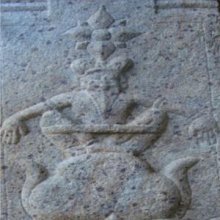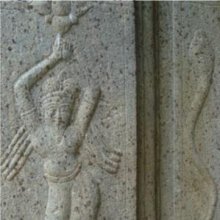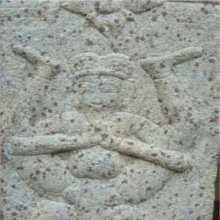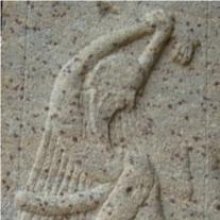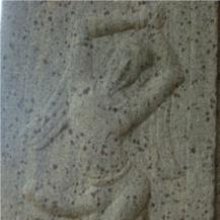Ashtatala, Aṣṭatāla, Aṣṭatala, Ashtan-tala: 5 definitions
Introduction:
Ashtatala means something in Hinduism, Sanskrit. If you want to know the exact meaning, history, etymology or English translation of this term then check out the descriptions on this page. Add your comment or reference to a book if you want to contribute to this summary article.
The Sanskrit terms Aṣṭatāla and Aṣṭatala can be transliterated into English as Astatala or Ashtatala, using the IAST transliteration scheme (?).
Images (photo gallery)
(+6 more images available)
In Hinduism
Purana and Itihasa (epic history)
Source: Cologne Digital Sanskrit Dictionaries: The Purana IndexAṣṭatāla (अष्टताल).—The normal height of man, 84 inches. Navatāla is superior man.*
- * Brahmāṇḍa-purāṇa II. 32. 9; Vāyu-purāṇa 59. 8.

The Purana (पुराण, purāṇas) refers to Sanskrit literature preserving ancient India’s vast cultural history, including historical legends, religious ceremonies, various arts and sciences. The eighteen mahapuranas total over 400,000 shlokas (metrical couplets) and date to at least several centuries BCE.
Shilpashastra (iconography)
Source: Shodhganga: The significance of the mūla-beras (śilpa)Aṣṭatāla (अष्टताल) refers to a type of measurement, as defined in the texts dealing with śilpa (arts and crafs), known as śilpaśāstras.—The unit of measurement chosen for stating the proportions of the images of the various gods, goddesses and other beings belonging to the Hindu pantheon is called the tāla. The for aṣṭatāla is prescribed for men.

Shilpashastra (शिल्पशास्त्र, śilpaśāstra) represents the ancient Indian science (shastra) of creative arts (shilpa) such as sculpture, iconography and painting. Closely related to Vastushastra (architecture), they often share the same literature.
Languages of India and abroad
Sanskrit dictionary
Source: DDSA: The practical Sanskrit-English dictionaryAṣṭatāla (अष्टताल).—A kind of sculptural measurement in which the whole height of an idol is generally eight times that of the face.
Derivable forms: aṣṭatālam (अष्टतालम्).
Aṣṭatāla is a Sanskrit compound consisting of the terms aṣṭan and tāla (ताल).
[Sanskrit to German]
Sanskrit, also spelled संस्कृतम् (saṃskṛtam), is an ancient language of India commonly seen as the grandmother of the Indo-European language family (even English!). Closely allied with Prakrit and Pali, Sanskrit is more exhaustive in both grammar and terms and has the most extensive collection of literature in the world, greatly surpassing its sister-languages Greek and Latin.
Kannada-English dictionary
Source: Alar: Kannada-English corpusAṣṭatāla (ಅಷ್ಟತಾಲ):—[noun] = ಅಷ್ಟತಾಳ [ashtatala].
--- OR ---
Aṣṭatāḷa (ಅಷ್ಟತಾಳ):—
1) [noun] = ಅಷ್ಟಕೋಣ [ashtakona].
2) [noun] 2) a variety in the rhythmic beating in keeping time in Karnāṭaka music system, having fourteen units of equal length, in each cycle.
Kannada is a Dravidian language (as opposed to the Indo-European language family) mainly spoken in the southwestern region of India.
See also (Relevant definitions)
Full-text: Caturyuga.
Relevant text
Search found 1 books and stories containing Ashtatala, Ashtan-tala, Aṣṭa-tala, Aṣṭa-tāla, Asta-tala, Aṣṭan-tāla, Astan-tala, Aṣṭan-tala, Aṣṭatāla, Astatala, Aṣṭatala, Aṣtatāla, Aṣṭatāḷa, Aṣtatāḷa; (plurals include: Ashtatalas, talas, tālas, Aṣṭatālas, Astatalas, Aṣṭatalas, Aṣtatālas, Aṣṭatāḷas, Aṣtatāḷas). You can also click to the full overview containing English textual excerpts. Below are direct links for the most relevant articles:
Manasara (English translation) (by Prasanna Kumar Acharya)
Related products

